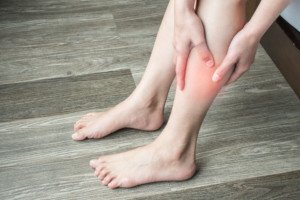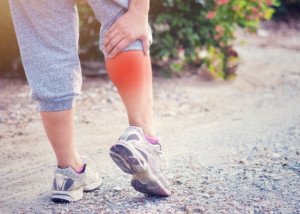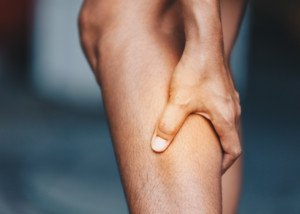Both sciatica and deep vein thrombosis can cause a lot of calf pain.
What’s troubling is that not all DVT pain comes with visible symptoms that strongly point towards this condition.
So the patient is left wondering, “Is my calf pain from a DVT or a flare-up of my sciatica or new-onset sciatica?”
Can the calf pain from a DVT feel identical to that from sciatica?
Well, calf pain from DVT is typically described as being a soreness, tenderness or cramp, including a really bad cramp, a la “Charlie horse.”
Calf pain from sciatica is typically described as shooting, stabbing, sharp and can be very severe.
Sciatica and DVT pain often come with other symptoms that can point heavily in one direction or the other.
But if just the symptom of pain is isolated and then compared, leaving out the consideration of other accompanying symptoms, it seems to be a situation of cramping or tenderness vs. sharp and shooting.
“Leg pain can mean very different things,” says J. Mark Anderson, MD, DABFM, of Executive Medicine of Texas and who is board certified in family medicine.
“When assessing and reporting leg pain, first make note of the place where the pain occurs,” continues Dr. Anderson.
“Is it worse with exercise?
“Is it sharp or dull?
“Is the leg hot or swollen?
“Where does it start and where does the pain end?
“The answers to these questions are very important in determining if the pain is associated with a serious condition known as deep vein thrombosis (DVT) or something painful, but less serious, like sciatica.
“DVT pain is often felt in the calf or in a specific region of the leg. It’s often worse with exercise and described as a burning or constant pain or cramp.

Shutterstock/TANAPAT LEK.JIW
“Since DVT is due to a blood clot, the leg is often warm to the touch at the spot where it hurts the most.
“DVT is a serious condition and medical attention should be sought immediately.
“Sciatica is pain that generally radiates from the buttock area and ‘shoots’ down the leg.
“It’s often described as a sharp pain that comes and goes. It can be made worse with certain standing or sitting positions.
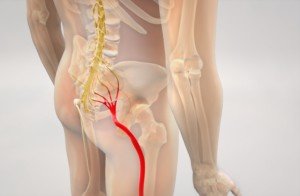
Shutterstock/Nathan Devery
“Some people experience foot or leg numbness or weakness due to sciatic nerve irritation, the cause of sciatica.
“Sciatica generally goes away with conservative treatment such as anti-inflammatories.”
Key Features of Sciatica Calf Pain
• Often described as shooting down the back of the thigh before reaching the calf.
• The same pain may be in both legs.
• There may be spasms in the calf.
• Sitting or standing may aggravate the pain.
• Lying down and even walking or jogging may relieve the pain somewhat.
• Possible accompanying symptoms are pain in the buttocks, thigh and foot; weakness in the calf or foot; and tingling or numbness in the thigh, calf or foot.
Key Features of DVT Calf Pain
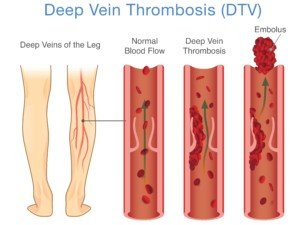
Shutterstock/solar22
• Cramp-like, burning or sore; may resemble a pulled muscle.
• Continuous; will not disappear with rest or keeping the leg still.
• Does not get better with sitting or lying down.
• Often worse with exercise
• Bending the foot so that the toes point upward may aggravate the pain.
• Possible accompanying symptoms are warmth and/or redness/pink in the painful area, and/or swelling. But remember, some DVTs present with only pain.
• Very recent history of risk factors increase suspicion of DVT such as recent very long trip cramped in an airplane or vehicle seat with minimal and especially zero intermissions of being up and around; prolonged bed rest; joint replacement or abdominal surgery.
If you suspect a DVT, a visit to the emergency room is strongly advised over making an appointment with your general practitioner — as the latter may not be able to see you right away and may not have access to ultrasound equipment (which can show a DVT).
An ER will have fast access to ultrasound and if you’re diagnosed, can immediately get you started with treatment.

Dr. Anderson is coauthor of the award-winning book, “Stay Young: 10 Proven Steps to Ultimate Health,” and host of the nationally syndicated Staying Young Show which goes to podcast as Staying Young Show 2.0.
 Lorra Garrick has been covering medical, fitness and cybersecurity topics for many years, having written thousands of articles for print magazines and websites, including as a ghostwriter. She’s also a former ACE-certified personal trainer.
Lorra Garrick has been covering medical, fitness and cybersecurity topics for many years, having written thousands of articles for print magazines and websites, including as a ghostwriter. She’s also a former ACE-certified personal trainer.
.

